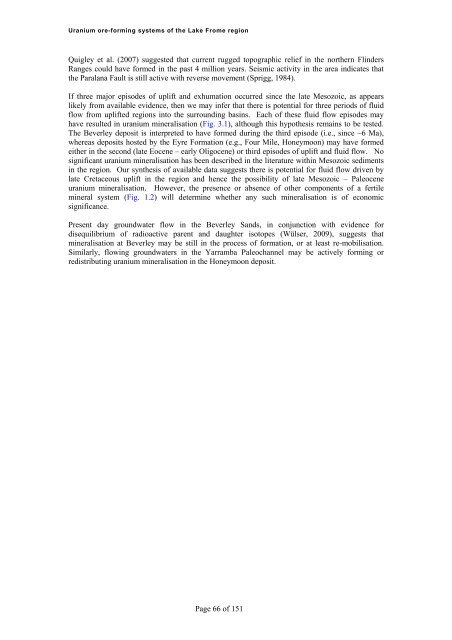<strong>Uranium</strong> <strong>ore</strong>-<strong>forming</strong> <strong>systems</strong> <strong>of</strong> <strong>the</strong> Lake Frome region5.4 TIMING OF URANIUM MINERALISATION: HYPOTHESES5.4.1 Maximum ages <strong>of</strong> mineralisationThe depositional ages <strong>of</strong> host rocks provide maximum ages <strong>of</strong> mineralisation. The Four Mile Eastzone and Honeymoon deposit are hosted by <strong>the</strong> Eyre Formation. Sediments <strong>of</strong> <strong>the</strong> Eyre Formationwere deposited in two separate episodes (late Paleocene to late Eocene, i.e. ~55 to 49 Ma; andearly middle Eocene to middle Eocene, i.e., ~45 to 37 Ma) interrupted by a period <strong>of</strong> nondepositionand possibly erosion (Fig. 3.1). Sedimentation <strong>of</strong> <strong>the</strong> Eyre Formation was terminatedby a period <strong>of</strong> uplift and erosion (Middle Eocene to Late Oligocene, i.e. ~37 to 28 Ma).Mineralisation at <strong>the</strong> Beverley deposit is hosted by <strong>the</strong> Beverley Sands in <strong>the</strong> Namba Formation.Palynological studies indicate that <strong>the</strong> age <strong>of</strong> <strong>the</strong> Namba Formation is between ~ 24 Ma and 4-6Ma (Martin, 1990, in Wülser, 2009, page 38).In most sandstone uranium <strong>systems</strong> <strong>the</strong> sandstone aquifers hosting mineralisation arehydrologically constrained between aquitards or aquicludes, and it is thought that mineralisationforms after <strong>the</strong> deposition <strong>of</strong> <strong>the</strong> upper aquiclude/aquitard (Dahlkamp, 1993). In <strong>the</strong> Lake Fromeregion <strong>the</strong> Eyre Formation contains an alternating series <strong>of</strong> interlayed aquifer (sand, silt) andaquitard (shale) units (e.g., Fig. 5.5). Hence, <strong>the</strong> maximum age <strong>of</strong> uranium mineralisation hostedby <strong>the</strong> Eyre Formation is that <strong>of</strong> <strong>the</strong> shaley/clay intervals overlying mineralisation in thisFormation. These are potentially as old as ~55 Ma. Alternatively, thick regionally distributedaquitards/aquicludes in <strong>the</strong> hangingwall <strong>of</strong> mineralisation may have been an important control ontiming <strong>of</strong> mineralisation. The Alpha Mudstone or Beverley Clay (Namba Formation) both couldhave functioned as regional seals. In this case, uranium mineralisation in <strong>the</strong> Eyre Formationwould have post-dated deposition <strong>of</strong> <strong>the</strong> Alpha Mudstone (late Oligocene to early Miocene, i.e.~28 to 20 Ma) or <strong>the</strong> Beverley Clay (late Miocene, ~10-6 Ma).Similarly, <strong>the</strong> Beverley Clay may have been a regional seal during formation <strong>of</strong> <strong>the</strong> Beverleydeposit. In this case, mineralisation at Beverley would have formed after ~6 Ma.In summary, based on depositional ages <strong>of</strong> host rocks and aquitards/aquicludes, <strong>the</strong> maximumages <strong>of</strong> mineralisation hosted by <strong>the</strong> Eyre Formation and Beverley Sands are ~55 Ma and ~6 Ma,respectively.5.4.2 Mineralisation timing constraints from uplift and cooling historyThe periods <strong>of</strong> uplift and erosion could be significant for <strong>the</strong> generation <strong>of</strong> sandstone uranium<strong>systems</strong> by creating highland topography in <strong>the</strong> region. Uplift <strong>of</strong> basement potentially can triggergravity-driven shallow-level groundwater flow into aquifer units surrounding <strong>the</strong> basement uplift,a concept supported by our numerical modelling (Chapter 7). These conditions also may befavourable for <strong>the</strong> leaching <strong>of</strong> uranium from uranium-rich source rocks in <strong>the</strong> basement. Thus, anunderstanding <strong>of</strong> uplift and cooling history may provide constraints on <strong>the</strong> timing <strong>of</strong>mineralisation.As noted in section 3.2 and illustrated in Figure 3.1, <strong>the</strong>rmochronological and o<strong>the</strong>r studies haverevealed three major episodes <strong>of</strong> regional cooling and corresponding uplift since <strong>the</strong> late Mesozoicin <strong>the</strong> Lake Frome region and Mt Painter Inlier in particular (Foster et al., 1994; Mitchell et al.,2002; Célérier et al., 2005; Quigley et al., 2007). Some <strong>of</strong> this uplift has occurred on <strong>the</strong> ParalanaFault Zone, located at <strong>the</strong> eastern margin <strong>of</strong> <strong>the</strong> Mount Painter Inlier. The fault system wasinitiated in <strong>the</strong> Mesoproterozoic and has been repeatedly reactivated. Early in <strong>the</strong> development <strong>of</strong>Neoproterozoic rifting it was active as an extensional or transtensional fault, and may have beenreactivated as a steep reverse fault in <strong>the</strong> Cenozoic and/or Quaternary (Preiss, 1995), commencingin <strong>the</strong> early Paleocene or even in <strong>the</strong> late Cretaceous (Mitchell et al., 2002). Observations <strong>of</strong> tiltedgravel deposits suggest that major uplift <strong>of</strong> <strong>the</strong> nor<strong>the</strong>rn Flinders Ranges occurred during <strong>the</strong> LatePliocene or Early Pleistocene (Foster et al., 1994). Using cosmogenic 10 Be erosion-rate estimatesPage 65 <strong>of</strong> 151
<strong>Uranium</strong> <strong>ore</strong>-<strong>forming</strong> <strong>systems</strong> <strong>of</strong> <strong>the</strong> Lake Frome regionQuigley et al. (2007) suggested that current rugged topographic relief in <strong>the</strong> nor<strong>the</strong>rn FlindersRanges could have formed in <strong>the</strong> past 4 million years. Seismic activity in <strong>the</strong> area indicates that<strong>the</strong> Paralana Fault is still active with reverse movement (Sprigg, 1984).If three major episodes <strong>of</strong> uplift and exhumation occurred since <strong>the</strong> late Mesozoic, as appearslikely from available evidence, <strong>the</strong>n we may infer that <strong>the</strong>re is potential for three periods <strong>of</strong> fluidflow from uplifted regions into <strong>the</strong> surrounding basins. Each <strong>of</strong> <strong>the</strong>se fluid flow episodes mayhave resulted in uranium mineralisation (Fig. 3.1), although this hypo<strong>the</strong>sis remains to be tested.The Beverley deposit is interpreted to have formed during <strong>the</strong> third episode (i.e., since ~6 Ma),whereas deposits hosted by <strong>the</strong> Eyre Formation (e.g., Four Mile, Honeymoon) may have formedei<strong>the</strong>r in <strong>the</strong> second (late Eocene – early Oligocene) or third episodes <strong>of</strong> uplift and fluid flow. Nosignificant uranium mineralisation has been described in <strong>the</strong> literature within Mesozoic sedimentsin <strong>the</strong> region. Our syn<strong>the</strong>sis <strong>of</strong> available data suggests <strong>the</strong>re is potential for fluid flow driven bylate Cretaceous uplift in <strong>the</strong> region and hence <strong>the</strong> possibility <strong>of</strong> late Mesozoic – Paleoceneuranium mineralisation. However, <strong>the</strong> presence or absence <strong>of</strong> o<strong>the</strong>r components <strong>of</strong> a fertilemineral system (Fig. 1.2) will determine whe<strong>the</strong>r any such mineralisation is <strong>of</strong> economicsignificance.Present day groundwater flow in <strong>the</strong> Beverley Sands, in conjunction with evidence fordisequilibrium <strong>of</strong> radioactive parent and daughter isotopes (Wülser, 2009), suggests thatmineralisation at Beverley may be still in <strong>the</strong> process <strong>of</strong> formation, or at least re-mobilisation.Similarly, flowing groundwaters in <strong>the</strong> Yarramba Paleochannel may be actively <strong>forming</strong> orredistributing uranium mineralisation in <strong>the</strong> Honeymoon deposit.Page 66 <strong>of</strong> 151
















